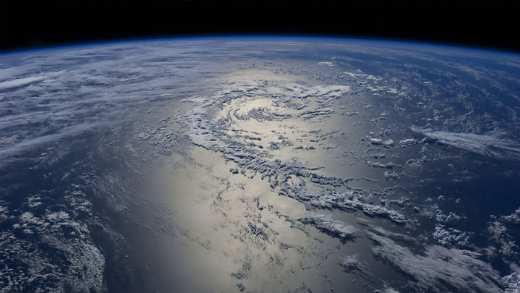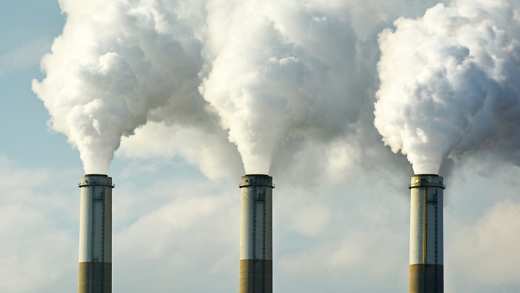The former Aviva CEO talks to AIQ about how the insurance industry is working to assess and manage the catastrophic risks of climate change.
7 minute read

The world is finally waking up to the scale of the climate crisis. As bushfires sweep Australia and floodwaters sluice through the streets of Venice, the risks are becoming impossible to ignore.
While climate change will affect every industry, it poses particular headaches for insurance companies. Fires, floods and storms destroy physical assets and leave insurers facing multimillion-dollar claims. A disorderly transition to a low-carbon economy could also erode the value of their investments.
Maurice Tulloch is keenly aware of these dangers. In his previous role as chief executive of international insurance at Aviva, he represented the company at the United Nations Investor Summit on Climate Risk in 2018. From 2014 to 2017, he served as chair of ClimateWise, an industry group that undertakes collaborative research into climate risk alongside academics at Cambridge University.
Climate change is one of Aviva’s main challenges over the medium-to-long term
Almost a year into his new role, Tulloch sees climate change as one of Aviva’s main challenges over the medium-to-long term. He worries climate change could render parts of the economy “uninsurable” – but he also finds grounds for hope in the recent surge of support for climate action among companies and individuals alike.
In this Q&A, Tulloch speaks to AIQ about the difficulties involved in modelling climate risk, the future for public-private partnerships, and how communities can protect themselves against extreme weather events.
Climate-related disasters are proliferating across the world. When did you start to appreciate the scale of the climate crisis?
The event that really startled me was the wildfire in Fort McMurray, Canada, which began in May 2016. If you’ve been to that part of the world, you will know there is often snow on the ground at that time of year. But in May 2016, the temperature exceeded 30 degrees Celsius on some days and the ground was tinder-dry. You could go back 1,000 years and it would never have been so warm in the spring, that far north. The fire destroyed more than 3,000 homes and buildings and displaced more than 85,000 people; it brought home the scale of the threat.
How would you score Aviva’s record on climate change so far?
We have been active in this area for a long time. Jeff Bezos has said he wants Amazon to become carbon-neutral by 2040; well, Aviva was carbon neutral in 2006.
We have one building that goes off-grid when conditions allow and our Perth site in Scotland will be completely off grid once works are completed
We have one building that goes off-grid when conditions allow, generating its own energy, and we are building a wind turbine and installing battery storage at our Perth site in Scotland. When those works are complete, that site will be completely off grid.
We also have a good record when it comes to raising awareness of the climate crisis and investing our assets responsibly. Our voice has been influential in projects such as the Task Force on Climate-related Financial Disclosures.
We are updating our climate strategy to make it more future focused
But, like every company, we should be doing more. We are updating our climate strategy to make it more future focused: We need to ask ourselves where we can make the biggest difference, and where our expertise will count. That means areas such as risk modelling and assessing the resilience of various assets, along with sustainable finance initiatives.
Bank of England Governor Mark Carney has said up to $20 trillion of assets could be wiped out by climate change. How is this risk shaping Aviva’s approach with its own investments?
I genuinely believe our investment approach is at the forefront of where the market needs to be. We engage with companies to improve their environmental, social and governance (ESG) records and, if we see no improvement, we divest. I think an engagement-led approach is the right one, and we will continue to use our influence as shareholders to push energy firms towards a credible transition plan, including through renewables.
Does Aviva refuse to insure certain companies due to concerns about climate exposure?
We don’t insure offshore oil, gas or thermal mining facilities, but we have insured on the periphery: contractors, say, or companies that move freight in and out. We are engaging with these firms. But you have to move at an appropriate pace, otherwise you wipe out value and damage the communities dependent on these industries. It’s about managing the transition. If people refuse to recognise the need to be more responsible with their businesses, then eventually you have to walk.
You mentioned risk modelling as another area of focus. Why is climate risk so difficult to model?
Part of the reason is the emergence of ferocious micro-climate systems that are difficult to predict. Take the flooding in Hull in 2013, which coincided with low atmospheric pressure and a high tide that brought water back onshore; within two hours the city was inundated. If that had happened 200 miles further south, the Thames Barrier might have failed.
Longer term, climate change has major implications. Modelling for all different scenarios is extremely tough
Over the longer term, climate change has major implications. You have the risk of pandemics, as diseases common in the tropics could spread further north, where people lack resistance to them. Warming oceans will kill off species of cold-water fish that many regions depend on for their food supply, so food security becomes a risk.
According to some scientists, climate change may even increase the frequency of earthquakes, although there is fierce scientific debate on that. If scientists prove there is a link, imagine if an earthquake snapped the natural-gas pipelines that run underneath a major city. How long would it take to put the fires out? The damage such a disaster would cause is almost unimaginable. Modelling all these different scenarios is extremely tough.
How would the insurance industry cope with a climate-related disaster in a major city?
Solvency II, the European Union’s regulatory framework, stipulates insurers must hold enough capital to withstand the losses that would occur due to the kind of catastrophe that hits once in every 200 years. But some climate-related disasters could be far more costly than that, especially if they hit densely populated urban areas.
Insurers must hold enough capital to withstand losses that would occur due to a once in every 200 years catastrophe but climate-related disasters could be far more costly
A climate-related incident that wipes out the power grid in a major city could take you up to policy limits. While the industry may not go bankrupt in that event, you could see a lot of failures. And on top of that, you have contagion risk, because the industry uses insolvency funds to take care of businesses that collapse, and those could fail as well.
What are the implications of climate change for insurance coverage?
There is an arms race going on in the industry to use data analytics to more-efficiently target various risks and provide cover. The problem is that every insurance company, big or small, has the same ten per cent or so of severe risks that are problematic to insure. Those include climate-related risks. And if insurance cannot cover these climate risks, there are big knock-on effects for the economy as a whole.
Those with more resources will be able to self-insure up to a certain level but those without resources won’t
Think about it: Across the world, not a spade goes in the ground unless a company has construction insurance. No-one gets a mortgage unless they have mortgage protection. Everything grinds to a halt if the capital owner lacks insurance against the unforeseeable.
Even where cover is available, it will become more expensive, potentially pricing some people out. In a riskier world, those with more resources will be able to self-insure up to a certain level – provided the market wants to take it – but those without resources won’t. There is already a huge protection gap in the African continent, where there is a massive need for microinsurance. My fear is that the climate crisis is creating huge pockets of uninsurability. A day of reckoning is coming.
Will governments have to step in to share the risk and close the protection gap?
Public-private partnerships may become the new norm. Flood Re, founded in 2016 as a partnership between the UK government and several insurers, including Aviva, is the best example. The scheme was precipitated by flooding events across Britain in the late 2000s and early 2010s. It is estimated that up to 350,000 homes will either find it difficult or even fail to get insurance in the future, so the government worked with insurers to enhance coverage.
How does the scheme work?
It is designed to make housing insurance more affordable for those facing higher flood risk, on the principle the premiums of the many pay the claims of the few. Insurers pay into the Flood Re fund, which is then used to reimburse the costs of flood-damage claims. The scheme has a fixed life of 25 years, ending in 2039.
Flood Re has modernised modelling, updated construction code and invested in education and awareness programmes
Initially, the industry wanted to label the flood risk premium on each individual policy, to make clear to policy-holders their policies had risen to pay for a scheme that would protect whole communities. The government rejected this idea, because it thought people were not ready to be socially inclusive and pay for a risk that might not affect them directly. That encapsulates the whole philosophical problem of dealing with climate change.
But the scheme has been successful. It has achieved three main things, beyond widening coverage. First, we worked to modernise the modelling of flood zones, to ensure that building permits were not issued in these areas. Second, we agreed an updated construction code that incorporated flood risk. And third, Flood Re has invested in education and awareness programmes, along with preventative measures such as dredging.
What would a climate change-resilient city and community look like?
It’s all about the readiness of a community to react to a climate-linked event. Start with homes. If your ground floor is at risk of flooding, putting in ceramic flooring and ensuring the electrics are located mid-wall, rather than in the base boards, are important provisions. In many parts of the world, houses are usually built to withstand 70-80 mile-per-hour winds; there’s nothing to stop homes being built to withstand 150-170mph winds.
People will need to be a little more patient and more willing to pay for infrastructure-type investments
The same principle applies to infrastructure. Take road systems. Using slag rather than gravel as the base material can improve resilience to flooding. The costs are incrementally higher during construction, but it costs twice as much if you have to fix these problems later.
Unfortunately, capital markets are still focused on the next quarter, and that short-term mindset makes it difficult to think about investing for the future. Maybe lower-for-longer interest rates will be beneficial, as people will need to be a little more patient, and more willing to pay for infrastructure-type investments that deliver a more sustainable cashflow stream over the longer term.
After the disappointing outcome of the UN Conference on Climate Change in December, do you have any conviction we will see a “top-down” solution to the climate crisis?
I have this feeling, given the negativity coming from some of the biggest carbon emitting countries, we will struggle to get the kind of compromise we need.
Citizens are demanding action, even if their governments are sceptical. Movement is happening at the local level
On the flip side, however, the real positive is that citizens are demanding action, even if their governments are sceptical. Movement is happening at the local level. In the US, for example, it’s now common for people to pay a little more upfront for their house to make it self-sufficient. Many homes now use wind, solar energy or the trickle of a nearby stream to generate power, then give it back to the grid when they don’t need it. That’s the future.
What is more effective in encouraging individuals and companies to reduce emissions – the carrot (in the way of incentives) or the stick (with penalties for the worst offenders)?
The carrot always wins. People have to be motivated and believe passionately in what they are doing. The world has used a lot of sticks. What we are seeing from young people involved in climate action today is more about positive motivation and a belief in what’s right.
People involved in climate action today are more positive and believe passionately in what they are doing
I am glad to see the idea of the carbon sink resurrected, in the form of the Trillion Trees initiative. The planet has survived even though it has been mistreated, and that’s because of photosynthesis: the only carbon-capture technology that’s been proven to work. The fires in the Amazon and the destruction of the boreal forest have highlighted the problem. We’ve forgotten the importance of planting trees. Aviva has pledged to plant 30,000 trees, which may not seem much in and of itself, but hopefully if other companies do the same, we can collectively make a big difference.
















